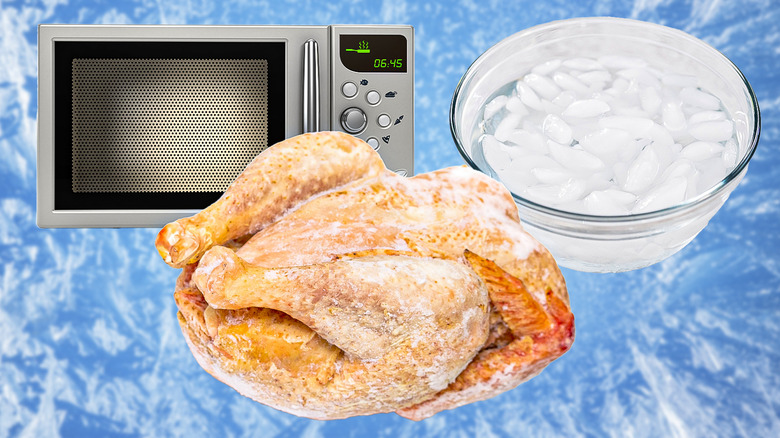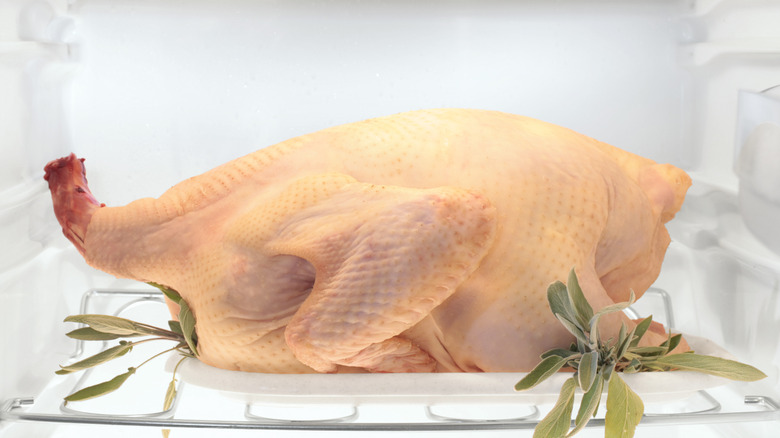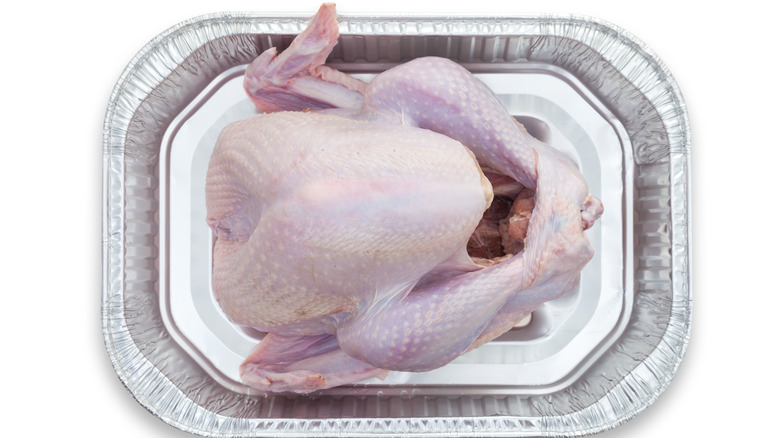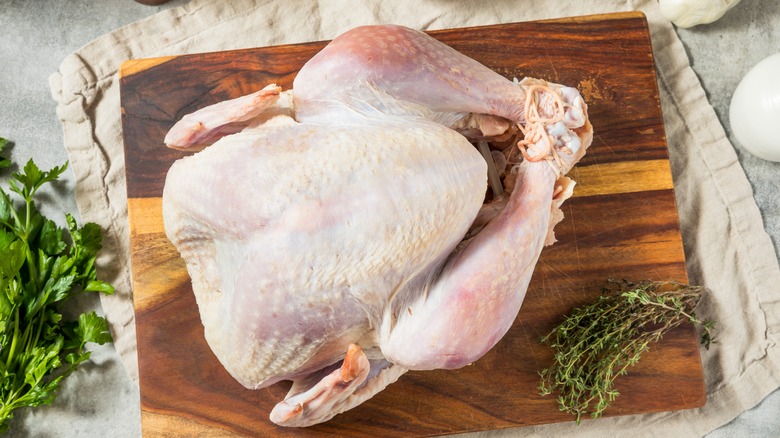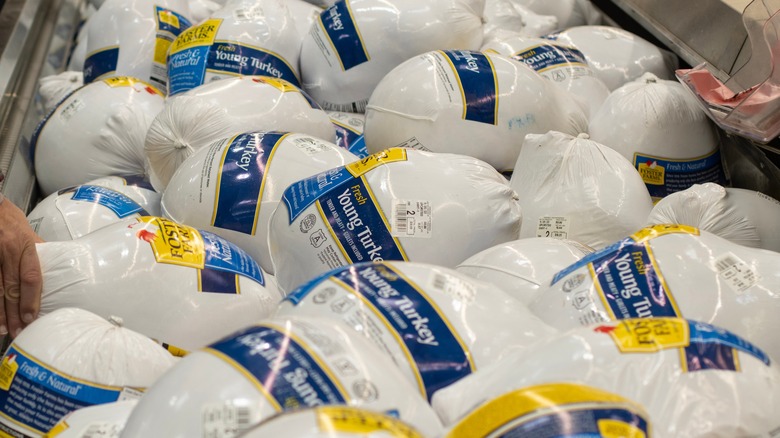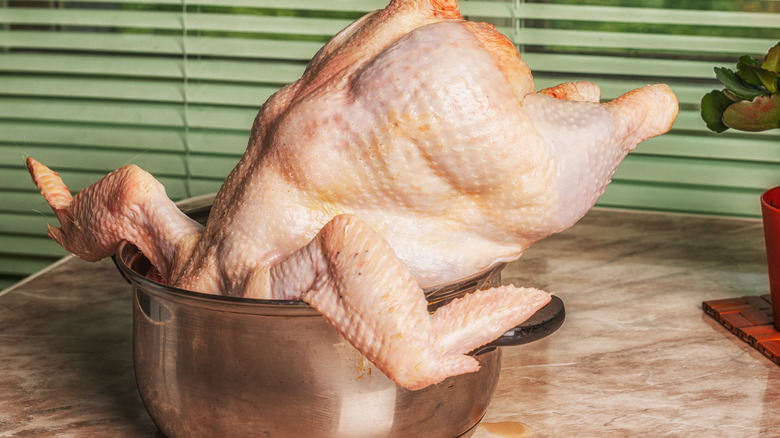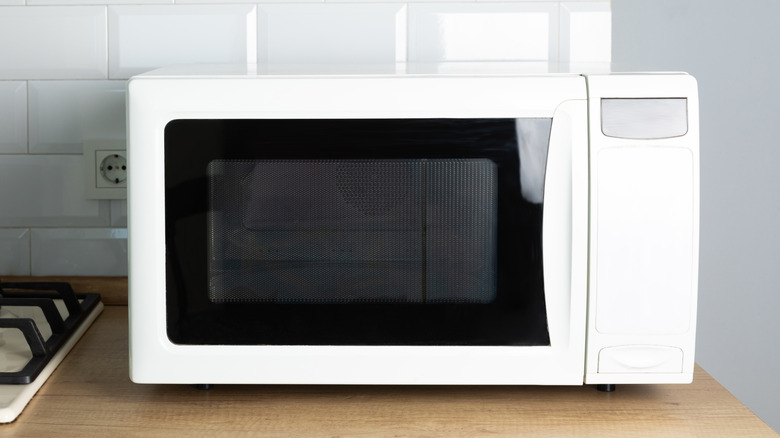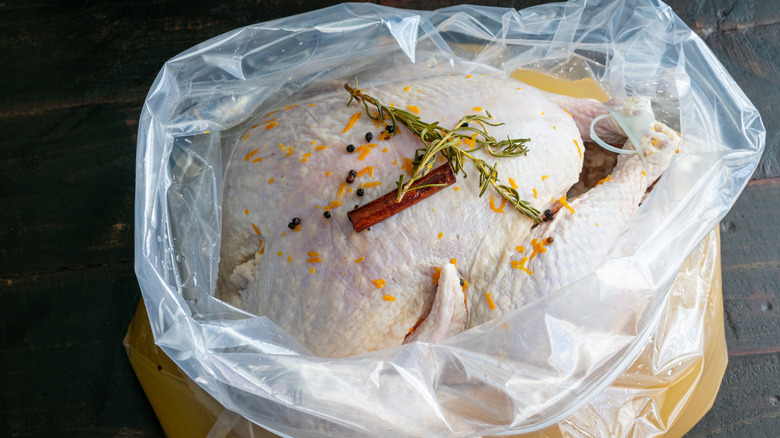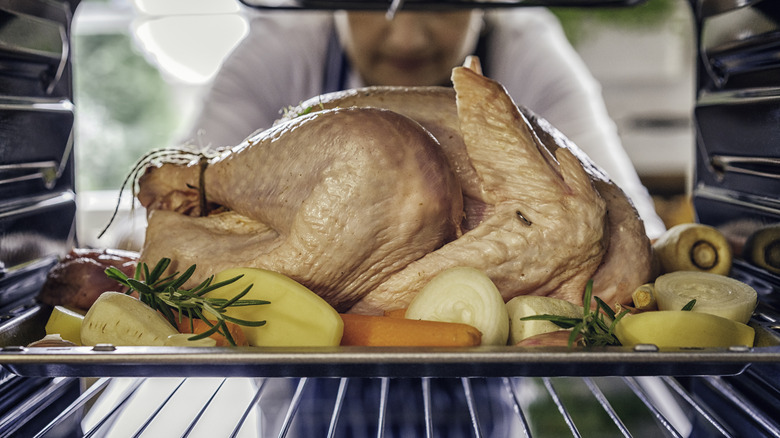8 Tips And Tricks For Thawing Frozen Turkey
Whether you look forward to appetizers, sides, or the pumpkin pie most of all on Thanksgiving, there's no denying that one food item reigns supreme year after year: the turkey. Starting in late October or early November, grocery stores overflow with an abundance of frozen turkeys, some small, some large, and some so gargantuan that it's a wonder it even fits in the freezer once you bring it home. Unless you're regularly in charge of the turkey each year, there's a good chance that cooking the Thanksgiving turkey is what weighs most heavily on your brain — but there's a crucial step that comes before cooking the bird, and that would be thawing it out.
Since turkeys are sold frozen at the grocery store, thawing out your bird is (mostly) essential before you can actually cook it. Now, this may seem like an intuitive fact, but the reality is that thawing a whole turkey takes a little more planning than thawing out a mere chicken breast or pork chop from the freezer, and this planning ahead aspect often catches first-time turkey chefs off guard. In case you've never had to worry about thawing a turkey or you just need a little reminder of the best (and safest) practices, we've compiled some tips and tricks to ensure that thawing your bird is a breeze.
Thaw your turkey in the fridge for the safest bet
While there are technically a few ways to thaw a turkey, the USDA recommends thawing a turkey in the fridge above all else. There are a few reasons why thawing your bird in the fridge is the best way to go. For starters, it's the most hands-off method, meaning that so long as you make the transfer from freezer to fridge with enough time to spare (we'll touch more on that in a bit), then you don't have to do anything else until it's time to cook (or brine, or season, or whatever you plan to do with your turkey). Sure, the turkey will take up a sizeable chunk of your refrigerator space for upwards of a week, but otherwise, there's no downside other than needing a bit of patience.
More importantly than convenience, thawing a turkey in the fridge is also the safest method, ensuring that no bacteria can grow (so long your fridge is kept at 40 degrees Fahrenheit or below) and your turkey can thaw at a consistent, steady pace. If you do go the refrigerator route, consider placing your turkey in some sort of container (like a disposable foil pan) to catch any juice or drippings that might come off the bird as it thaws.
Give your turkey enough time to thaw
Regardless of which method you use to thaw your turkey, planning ahead is required, but especially so if you go the refrigerator route. Per the USDA, you need about one day for every 4 to 5 pounds of turkey, meaning that if you have a 20-pound bird, it should be going in the fridge by the Saturday or Sunday before Thanksgiving. And if you bought a bird even bigger, expecting to feed a huge crowd, then you might have to transfer it to the fridge upwards of a week before the big day.
For those who tend to lose track of time around the holidays, the fact that you have to plan so ahead to transfer your turkey to the fridge is the biggest drawback of the refrigerator method. The good news is that small- to medium-sized birds only need a few days to thaw in the fridge, so even if you're a little late to the game, there may still be time to make the transfer. And, for those who are worried that they put their turkey in the fridge a little too early, the USDA also notes that once fully thawed in the fridge, a turkey will still remain safe to cook for up to two days, so there is some wiggle room.
Avoid thawing a turkey at room temperature
Growing up, it's possible that you watched your mom take a frozen turkey out of the freezer the night before Thanksgiving and leave it to thaw on the countertop at room temperature overnight. And, hey, clearly, you lived through eating the turkey the next day; but in all seriousness, thawing poultry at room temperature should be avoided at all costs. Sure, it thaws a turkey out pretty quickly, but it also encourages bacteria growth and ultimately makes the turkey unsafe for consumption, even after it's cooked.
According to the USDA, frozen meat that has been at room temperature for even two hours is no longer safe; so, naturally, a turkey that's been sitting at room temperature overnight or upwards of an entire day is going to be in the food "danger zone," a temperature range between 40 and 140 degrees Fahrenheit. When raw meat is in this danger zone temperature range, it simply means that bacteria can and will grow on your food, and quite rapidly at that. Even though the turkey will eventually bake at a high temperature, it's not worth the risk of exposing yourself and your loved ones to any lingering or heat-resistant bacteria.
Thaw your turkey in a cold water bath for faster results
Planning ahead and refrigerating your turkey may sound fine and dandy weeks before Thanksgiving ... but if you're reading this the day before Thanksgiving with a 20-pound bird still frozen, that method simply isn't going to cut it. Luckily, there is a faster way to thaw a turkey, though it is a more hands-on approach that requires some round-the-clock work on your part. This quicker method involves soaking the turkey in a cold water bath — not room-temperature water and certainly not hot water, which means that you'll have to change out that water pretty consistently to keep it cold.
The USDA says that the cold water method will take approximately 30 minutes per pound of turkey, so if your turkey is 10 pounds, it'll take about 5 hours to thaw. What's more is that you should be changing the water every 30 minutes to make sure that it doesn't teeter into room temperature territory, which is the price you pay for a speedier thawing session. Also, per the USDA, you should keep the turkey in its packaging and either submerge it in the kitchen sink or a large pot, bowl, or container.
Don't pour hot water over your turkey
Since a cold water bath is on the table when it comes to thawing a turkey, you may be thinking that a hot water bath is not only also a viable option, but perhaps even a speedier one. Alas, a hot water bath is a big no-no when it comes to thawing a turkey, as is pouring hot or boiling water over your turkey.
Essentially, a hot water bath or pouring hot water over a frozen turkey is a bad idea for the same reason that leaving a turkey out to thaw at room temp is a bad idea — it encourages bacteria growth. Remember the danger zone that we talked about earlier? Pouring hot water over a turkey risks putting certain parts of the turkey above 40 degrees Fahrenheit, but still below 140 degrees Fahrenheit, meaning that bacteria will likely find a lovely new home atop your uncooked bird, possibly at an even faster rate than if you would have just left the turkey out overnight.
Thaw your turkey in the microwave in a pinch
Let's say that you're frantically reading this article on the day of Thanksgiving with a bird that's still mostly frozen, and the refrigerator or cold water bath thawing methods are simply not options at this point. Don't panic — as long as you have a microwave, then Thanksgiving is far from ruined. Though the microwave thawing method is perhaps the most hands-on one of all, and requires near-constant inspection of the turkey to make sure that it's thawing but not actually cooking, it is by far the quickest method (that's still considered safe), so if you're in a bind, get ready to microwave your bird.
Now, naturally, the microwave method is contingent on your appliance being big enough to fit the turkey (and some sort of microwave-safe dish for the bird to sit in). If you're good to go on that end, the USDA recommends consulting your microwave's owner manual and giving the defrost section a good read. If you don't have your manual handy, plan to microwave your bird for about six minutes per pound, and be sure to remove any packaging before sticking it into the appliance. Also, keep in mind that you may need to give the turkey brief breaks in between zaps, in case it starts to cook as opposed to just thaw. And once the bird is fully thawed, the actual cooking-in-an-oven part needs to happen right away.
Brine your turkey as it thaws
Many people find thawing a turkey to be a nuisance not just for the process itself but because they think that any brining or seasoning action isn't possible until the bird is fully unfrozen. Fortunately, that's not necessarily the case, and you actually can wet brine a turkey as it thaws — a great option for those who were going with the refrigerator method anyway.
The only caveat of wet brining your turkey while it thaws is that it takes some planning and coordination. You don't want to pull your turkey out of the freezer, stick it in a brine, and toss the whole thing in the fridge for a week. Depending on size, you really don't want to brine even bigger turkeys for more than a full 24 hours, so that's where the planning part comes in. Let your turkey thaw in the fridge for a few days, then the day before Thanksgiving, when it's still a bit frozen, transfer the bird to your brine bag and return it to the fridge. The next day, your turkey should not only be finished thawing, but it'll also be infused with plenty of flavor — a true win-win.
Skip thawing the turkey and cook it frozen
When all else fails, and it seems that thawing your turkey just isn't in the cards at all, you don't have to completely give up on the bird altogether. Instead, you can opt for a last resort, which is cooking the turkey while it's still frozen. Yes, even completely frozen turkeys can go right into the oven, but according to the USDA, they'll take 50% longer to cook than their non-frozen counterparts, so you'll need to plan accordingly.
There's a good chance that your turkey won't be completely frozen on Thanksgiving morning but rather still partially frozen, which means that it might not take 50% longer to cook. However, it will likely still take longer, so a meat thermometer is your best friend in this scenario. That way, you'll know exactly when the bird is done. Also, keep in mind that cooking a turkey while still frozen is only an option when it comes to baking and not for those who want to deep-fry a turkey. A turkey needs to be completely thawed and completely dry to be deep-fried; otherwise, it's a huge fire and safety risk. So, for those with partially frozen birds on Thanksgiving day, stick to the trusty oven to get the job done.
